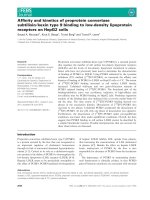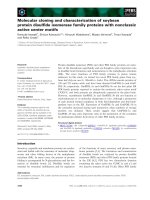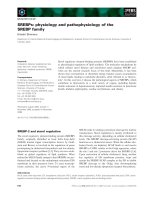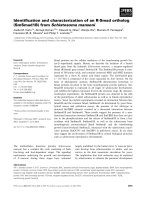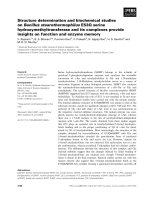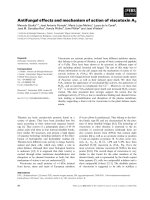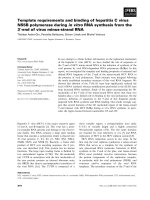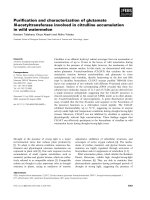Báo cáo khoa học: Structure, location and interactions of G-quadruplexes pdf
Bạn đang xem bản rút gọn của tài liệu. Xem và tải ngay bản đầy đủ của tài liệu tại đây (120.18 KB, 7 trang )
MINIREVIEW
Structure, location and interactions of G-quadruplexes
Julian L. Huppert
Cavendish Laboratory, University of Cambridge, UK
Introduction
Nucleic acids can form a very wide range of different
structures, aside from the well-known DNA double
helix. This double helix is highly unusual in that the
structure is largely independent of the sequence. For
other structures, what form they adopt, and how sta-
bly, is controlled by their sequences, and in particular
the different chemical properties of the nucleobases.
It was noted in 1910 that guanine behaved differ-
ently from all other nucleobases, in that it could spon-
taneously form a gel [1]. It then took over 50 years for
the structure responsible to be discovered [2]. The core
consists of square arrangements of four guanines,
bound together using two hydrogen bonds for each
side of the square, and with a monovalent cation (pref-
erably K
+
) in the centre. These squares, known as
G-tetrads, can then stack on each other to form higher
order structures called G-quadruplexes, typically with
the cations now in the interstices, each interacting with
eight guanines [3,4].
Although these structures can form from individual
guanine bases, in a biological context there are few
free bases around and they form from DNA (or RNA)
sequences, with the bases held together by the back-
bone. These structures vary in their molecularity and
may be tetramolecular, with one guanine in each
square coming from a particular strand, bimolecular
or unimolecular. In these latter two cases, there are
loops connecting different runs of guanine and these
loops play a very important role in controlling the
details of the structure and stability of the resulting
G-quadruplex [5].
For a while, G-quadruplexes were simply a struc-
tural curiosity, but recently it has become clear that
they play important physiological roles. They are
found in telomeres [6] and have been implicated in reg-
ulating transcription, translation and replication [7].
This interest has been reflected in the rate of publi-
cation, with an exponential growth in the number of
Keywords
bioinformatics; biophysics; computational
biology; DNA; G-quadruplex; G-quartet;
G-tetraplex; genomics; RNA; transcription;
translation
Correspondence
J. L. Huppert, Cavendish Laboratory,
University of Cambridge, JJ Thomson Ave,
Cambridge CB3 0HE, UK
Fax: +44 1223 337000
Tel: +44 1223 337256
E-mail:
(Received 23 February 2010, revised 23
May 2010, accepted 30 June 2010)
doi:10.1111/j.1742-4658.2010.07758.x
Four-stranded G-rich DNA structures called G-quadruplexes have been
the subject of increasing interest recently. Experimental and computational
techniques have been used to implicate them in important biological pro-
cesses such as transcription and translation. In this minireview, I discuss
how they form, what structures they adopt and with what stability. I then
discuss the computational approaches used to predict them on a genomic
scale and how the information derived can be combined with experiments
to understand their biological functions. Other minireviews in this series
deal with G-quadruplex nucleic acids and human disease [Wu Y & Brosh
RM Jr (2010) FEBS J] and making sense of G-quadruplex and i-motif
function in oncogene promoters [Brooks TA et al. (2010) FEBS J].
Abbreviations
FRET, fluorescence resonance energy transfer; UTR, untranslated region.
3452 FEBS Journal 277 (2010) 3452–3458 ª 2010 The Author Journal compilation ª 2010 FEBS
articles mentioning the term G-quadruplex (or G-tetra-
plex, an alternative name) over the past decade.
In this minireview, I describe the detailed structure
of various G-quadruplexes and the computational
tools that may be used to predict their formation and
stability. I then describe where they are found in the
genomes of various organisms and how such informa-
tion allows us to predict their functionality.
Topological variety
G-quadruplex structures may be considered to be com-
prised of a core G-rich component, consisting of
G-tetrads stacked on top of each other and zero or
more connecting loops, which may be of variable
composition.
The G-rich core typically consists of two or more
stacked G-tetrads with a right-handed helical twist.
The stacks are joined together by the normal sugar–
phosphate backbone. The binding energy arises from
three main factors: hydrogen-bonding between the
guanines in a plane, p–p interactions between the gua-
nines in adjacent planes and charge–charge interactions
between the partially negative O
6
of the guanines and
cations that typically sit in the octahedral position
between the stacks. Monovalent cations, especially
K
+
, are particularly stabilizing. Varying any of the
bases to non-G bases is highly destabilizing and such
mutant sequences are unlikely to form G-quadruplexes
in vivo [8].
This G-core can form the major part of the struc-
tures that form, as found in short sequences such as
d(TGGGGT)
4
, which tetramerizes to form a four-
stacked G-quadruplex with trailing ends [9]. Another
example is G-wires, very long polymeric sequences of
continuously stacked G-tetrads. These are currently
being investigated for their interesting electronic prop-
erties [10].
In biological contexts, however, multimerization is
relatively unlikely and most interest has focused on
unimolecular G-quadruplexes. This requires at least
four runs of guanine to be joined together by (at least)
three loops. These loops can have varying length and
sequence, and this controls the topology of the final
structures and is related to the direction of the G-rich
strands making up the core.
Loops may link positions on the top (or bottom) of
the stacks, forming diagonal or lateral loops depending
on which guanines are being linked. Alternatively, they
may link a guanine on the top of the stack to a guan-
ine on the bottom, resulting in a double-chain reversal
loop. Further details and images are available in Phan
[11].
The nature of the loops is also related to the direc-
tionality of the four G-rich runs making up the core of
the structure – these may be parallel (requiring double-
chain reversal loops) [12], antiparallel (with two
strands running in each direction and either lateral or
diagonal loops) [13] or a mixed ‘3 + 1’ hybrid, with
three strands in one direction and one in the other,
and a mixture of loop types [14]. Which of these struc-
tures is preferred depends on the sequence and length
of the loops – in general, shorter loops favour parallel
structures [15].
There are also more exotic ways of arranging the
loops, as found in one G-quadruplex taken from the
promoter of the c-kit oncogene – its structure involves
various internal loops [16].
Given this complexity, there are clearly many possi-
ble structures for most G-quadruplex-forming
sequences and experimental evidence suggests that in
many cases they are of very similar energies. Hence,
many of these structures seem to exist in vitro as a set
of polymorphs and small changes in the conditions can
favour one or more different detailed structures. As an
example, the human telomeric repeat (see below) has
been shown to form parallel, antiparallel and hybrid
structures under subtly different conditions [17]. This
is clearly a big challenge both for structure determina-
tion and also for targeting, whether pharmaceutically
or naturally.
Telomeres in organisms
All organisms with linear chromosomes have to mark
out the ends of their chromosomes in order to distin-
guish them from unwanted double-strand breaks [18].
In all species studied to date, this is achieved with
repetitive sequences of variable lengths characterized
by runs of guanines on one strand. In humans, there
are typically around 1000 repeats of the sequence
d(GGGTTA) in duplex form, followed by a single-
stranded overhang of hundreds of bases. All
vertebrates have the same sequence and most other
organisms have very slight variants on this basic
sequence, of the form d(G
2–4
T
1–4
A
0–1
). All of these
have been shown to form stable G-quadruplexes under
appropriate in vitro conditions.
This remarkable property, suggesting that all linear
chromosomes have G-quadruplex caps, implies
strongly that there is a function to these structures.
Because telomeric regions are generally capped by a
wide variety of proteins, it is not entirely clear exactly
what form the DNA adopts in vivo [19,20]. By devel-
oping an antibody that bound specifically to parallel
G-quadruplexes,
J. L. Huppert Structure, location and interactions of G-quadruplexes
FEBS Journal 277 (2010) 3452–3458 ª 2010 The Author Journal compilation ª 2010 FEBS 3453
Plu
¨
ckthun and co-workers [21] demonstrated that
G-quadruplexes form in vivo in the ciliate Stylonichia
lemnae. Although this was an elegant experiment, it
has not been replicated for other organisms and it is
possible that G-quadruplex formation is induced by the
presence of the antibody, although si-RNA experiments
suggest that this is not the case [19]. Nonetheless, it is
hard to see how G-quadruplexes cannot play a critical
role in telomere structure and function.
Predicting G-quadruplexes
An active field of research at the moment is to inves-
tigate whether G-quadruplexes can form in locations
in the genome other than just the telomeres, and
what other functions they may have. In order to do
this, however, it is necessary to have a way of pre-
dicting G-quadruplex formation for other sequences
[22–24].
The simplest approach is to identify a G-quadru-
plex-like sequence in a region of interest and then to
study it in vitro. This approach was taken in the classic
work by Hurley on the c-myc oncogene [25,26]. The
NHE III
1
domain of the c-myc promoter was known
to be a transcriptional repressor; Hurley proposed and
then demonstrated that it could form a G-quadruplex
and suggested that this could be responsible for the
repressor activity.
However, such identifications do not lend themselves
to widespread target discovery and it is necessary to
develop some kind of predictive algorithm to identify
possible sequences. We [27] and others [28,29] have
developed a variety of different predictive tools, which
are reviewed elsewhere [22,23]. Our tool, quadparser,
is freely available online at />?view=quadparser and identifies sequences of the form
G
3+
N
1–7
G
3+
N
1–7
G
3+
N
1–7
G
3+
, with four runs of gua-
nines separated by variable loops [27].
This and other tools are based on a series of biophysi-
cal experiments that have been performed, studying the
thermodynamic equilibrium of G-rich oligonucleotides
between a G-quadruplex form and an unstructured
single strand. These experiments are typically performed
using either ultraviolet melting [30] or fluorescence
melting [31] and have led to much information associa-
ting stability with particular sequences [32].
However, there are a number of problems with the
results so far. First, our ability to accurately predict
structure or stability for a novel sequence is very lim-
ited. We have recently taken a Bayesian inference
approach to come up with the first evidence-based pre-
dictor for stability. This method uses Bayesian calcul-
cations to learn from experimentally determined data
and allows predictions of thermal stability for new
input sequences under various conditions. However,
further data are required for it to be more accurate
and it currently only predicts the melting temperature
rather than more detailed thermodynamic parameters
[33]. It is freely available for use online at http://
www.quadruplex.org/?view=quadpredict.
Second, the experiments largely describe only a sin-
gle-strand folding and say little about the effects of
having the complementary strand present. Experiments
that have been done show that, as expected, the com-
plementary strand tends to favour the formation of
duplex DNA [34], but it is not clear for which
sequences G-quadruplexes will still form and with
what stability compared with the duplex. Elegant
experiments using FRET in plasmids show that
G-quadruplexes can exist in a duplex context, but it is
not yet possible to generalize this result [35]. Interest-
ingly, the complementary strand of a G-quadruplex
may form an alternative C-rich structure called an
i-motif, which contains hemi-protonated C ” C+ base
pairs [36].
Lastly, all the experiments are performed in vitro,
and so omit many factors that would be present
in vivo. These factors include the many proteins that
interact with G-quadruplexes, stabilizing, destabilizing
(e.g. acting as helicases) or cleaving them [37]. It also
neglects the presence of nucleosomes [38], which stably
bind duplex DNA. Supercoiling is also neglected,
although experimental evidence for both c-kit and
c-myc show that it can play a significant role in
promoting G-quadruplex activity [39]. Also, in vitro
experiments are generally performed in dilute aqueous
solution, although it has been repeatedly shown that
molecular crowding (as found in vivo) can induce
G-quadruplex formation [40,41].
Despite these limitations, much work has been per-
formed developing and refining these predictors, which
allows broad-scale studies of the presence of G-quad-
ruplex-forming units in many organisms’ genomes. In
humans, for example, there are 375 000 possible
quadruplex-forming sequences, although it is unlikely
that all of these would in fact form in vivo [27,28].
Nonetheless, it is interesting to note that this is signifi-
cantly below the number that would be expected by
chance, suggesting an evolutionary pressure to reduce
the number.
Genomic locations
Predicted G-quadruplexes are not located randomly
throughout the genomes and tend to cluster together
in particular regions. Coupled with the depletion
Structure, location and interactions of G-quadruplexes J. L. Huppert
3454 FEBS Journal 277 (2010) 3452–3458 ª 2010 The Author Journal compilation ª 2010 FEBS
across the whole genome, this is highly suggestive of
evolved functionality.
Aside from telomeres, one of the first regions con-
sidered for the presence of G-quadruplexes was gene
promoters. Hurley’s work on c-myc established the
principle that such sequences could regulate gene tran-
scription [25,26] and other examples, such as c-kit
[42,43], were then found [44]. These are discussed in
more detail in one of the other minireviews in this
series [45].
Computational analyses of the entire human genome
showed that G-quadruplexes were in fact very likely to
be found just upstream of gene TSS positions. Indeed,
almost half of all known genes have a putative
G-quadruplex in their promoter in a position where it
could be involved in gene regulation. These G-quadru-
plexes tend to be more thermodynamically stable than
typical [46].
These genes are not random in terms of their func-
tions. Oncogenes are more likely, and tumour supres-
sors less likely, to contain G-rich sequences [29].
Detailed GO code analysis showed in general that
genes that are involved in regulation (e.g. transcription
factors) are more likely to have promoter G-quadru-
plexes, whereas ‘housekeeping’ genes (e.g. those
involved in protein biosynthesis) tend to be depleted in
G-quadruplexes [46]. Interestingly, genes involved with
olfaction are extremely depleted, raising questions
as to their evolutionary history and how they are
regulated.
Similar results have been found in a wide variety of
other organisms, yielding similar results for other ver-
tebrates and comparable results for other eukaryotes
and prokaryotes.
RNA is also capable of forming G-quadruplex struc-
tures and indeed forms them even more stably than does
DNA. In addition, whereas DNA in biological systems
is typically double-stranded, RNA is typically single-
stranded, and so G-quadruplex formation does not have
to compete with duplex formation and is hence more
likely. However, a wide range of alternative structures is
possible in addition to G-quadruplexes [47].
The question therefore arises as to whether RNA
G-quadruplexes could play a role in translation regula-
tion, in a manner analogous to DNA G-quadruplexes
and transcription. We identified a predicted G-quadru-
plex in the 5¢-UTR of the N-ras oncogene, and demon-
strated that it could form a G-quadruplex in vitro, and
that the formation of the G-quadruplex led to a signifi-
cant (fourfold) reduction in the amount of protein pro-
duced for a given amount of mRNA [48]. This work
has since been developed by others, who have investi-
gated how the positioning affects the effect [48] and
demonstrated that this mechanism applies in vivo in
prokaryotes and eukaryotes [49,50].
Although the algorithms used to predict G-quadru-
plexes have been created based on data from DNA
experiments, it is still approximately possible to modify
them to predict RNA G-quadruplexes, although con-
siderable further work is needed to bring the accuracy
of such predictions up the same level as for DNA.
Nonetheless, the tools available can give a clear indica-
tion of the location of G-quadruplexes in RNA form-
ing sequences [51].
The first thing that is clear is that there is distinct
asymmetry between the coding strand and the template
strand – there are relative few G-quadruplex motifs in
the coding strand, suggesting that they have been dis-
favoured in general. However, those that still exist do
cluster at the 5¢-end of the 5¢-UTR of many thousand
genes [51]. As with promoter G-quadruplexes, there is
a clear selectivity in terms of gene functions. Interest-
ingly, there is a localized concentration of G-quadru-
plexes immediately after the transcription end site of
some genes, particularly those with additional genes
immediately downstream. These are regions that
should never be transcribed, and have been associated
with regulation of transcription termination via a paus-
ing mechanism. Studies using an antibody evolved to
specifically bind G-quadruplexes showed that gene
expression changed significantly for genes with
G-quadruplexes in their promoters, in the 5¢-UTR or
around the 3¢-UTR, suggesting a widespread range of
functions and a complex response [52].
Duplex DNA in cells is not naked, but is stored as
nucleosomes, wrapped around histone proteins. These
structures would be expected to have the effect of sta-
bilizing the duplex form and preventing the formation
of G-quadruplexes or any other secondary structures.
However, nucleosomes are not present along the entire
genome and there are gaps between nucleosomes, of a
size large enough to allow G-quadruplex formation
[38]. Notably, the promoter region immediatetely
upstream of genes, where G-quadruplexes are espe-
cially common, are denuded on nucleosomes. This
inverse association holds true across the human gen-
ome, with stable G-quadruplex sequences located in
general in the gaps between nucleosomes. This is con-
sistent with them having a function derived from their
structure, either as a result of evolutionary pressure to
move them into gaps, or because the formation of
G-quadruplex structures prevents nucleosomes from
forming in those locations [53].
As previously discussed, the presence of a comple-
mentary strand of DNA disfavours G-quadruplex
formation and so we may expect that G-quadruplex-
J. L. Huppert Structure, location and interactions of G-quadruplexes
FEBS Journal 277 (2010) 3452–3458 ª 2010 The Author Journal compilation ª 2010 FEBS 3455
based functionality may be more likely when DNA is
single-stranded. Such conditions are found as standard
in telomeres, where there is a single-stranded overhang,
and during replication, when the strands must be sepa-
rated; G-quadruplex formation has been proposed for
both of these. One other, rarer, occasion when DNA is
single-stranded is a G-loop [54], the product of
transcription of certain AG-rich sequences where the
stability of the normally transient RNA ⁄ DNA hybrid
outweighs the DNA duplex, resulting in the formation
of a loop with the complementary DNA strand being
unbound [55]. These structures have been shown to
form in immunoglobulin class switch regions, and
may occur elsewhere. G-loop formation in plasmids
has been shown directly and indirectly to lead to
G-quadruplex formation and this may form part of
the switching mechanism [54,56].
Conclusions
G-quadruplex-forming sequences have been proposed
to play a wide range of physiological roles, including
in all the processes of the Central Dogma. Experimen-
tal studies have confirmed these functions in a number
of specific genes and computational methods have
given statistical evidence that these structures may be
widespread in the genomes of many organisms. How-
ever, further evidence is required to demonstrate
clearly exactly how many of these possible G-quadru-
plexes do actually form in vivo and to clarify many of
the details of the mechanisms involved.
In general, it seems that G-quadruplexes are gener-
ally a bad thing and most organisms are depleted in
sequences that could form them. However, some spe-
cific locations and specific G-quadruplexes appear to
be highly amplified, presumably as a result of evolu-
tionary pressures. Given the stability of the G-quadru-
plex compared with the duplex, it seems unlikely that
they form permanently (except at telomeres or in
RNA), but are likely to be a relatively minor compo-
nent at equilibrium. They therefore function as
switches, forming in response to stimuli such as super-
coiling changes. Once formed, they are sufficiently
metastable to be long-lived, especially with protein sta-
bilization, and can therefore control other processes,
whether by acting as steric blocks, occluding other
active DNA sites or recruiting proteins that bind them.
Once the trigger is removed, helicase activity (for
example) can then return them to their original duplex
state, ready for retriggering. At any given time, the
number of folded G-quadruplexes in a given cell may
be extremely low, although many may form during the
lifetime of the cell.
This field is still relatively new, but has come a long
way in terms of establishing hypotheses and providing
proof of concept and statistical evidence for many of
them. Over the next few years, it will become essential
to investigate more of the details of the field, and
establish exactly how important they are in vivo.Iam
sure the field will rise to the challenge and continue to
be an exciting place to work.
Acknowledgements
JLH is a Research Councils UK Academic Fellow and
Member of Parliament for Cambridge. Caroline
Wright is thanked for helpful discussions and Jaime
Gomez Marquez is thanked for extreme patience.
References
1 Bang I (1910) Untersuchungen u
¨
ber die Guanylsa
¨
re.
Biochemische Zeitschrift 26, 293–311.
2 Gellert M, Lipsett MN & Davies DR (1962) Helix
formation by guanylic acid. Proc Natl Acad Sci USA
48, 2013–2018.
3 Huppert JL (2008) Four-stranded nucleic acids: struc-
ture, function and targeting of G-quadruplexes. Chem
Soc Rev 37, 1375–1384.
4 Burge S, Parkinson GN, Hazel P, Todd AK & Neidle S
(2006) Quadruplex DNA: sequence, topology and struc-
ture. Nucleic Acids Res 34, 5402–5415.
5 Lane AN, Chaires JB, Gray RD & Trent JO (2008)
Stability and kinetics of G-quadruplex structures.
Nucleic Acids Res 36, 5482–5515.
6 Neidle S & Parkinson GH (2003) The structure of
telomeric DNA. Curr Opin Struct Biol 13, 275–283.
7 Patel DJ, Phan AT & Kuryavyi V (2007) Human telo-
mere, oncogenic promoter and 5¢-UTR G-quadruplexes:
diverse higher order DNA and RNA targets for cancer
therapeutics. Nucleic Acids Res 35, 7429–7455.
8 Gros J, Rosu F, Amrane S, De Cian A, Gabelica V,
Lacroix L & Mergny JL (2007) Guanines are a quartet’s
best friend: impact of base substitutions on the kinetics
and stability of tetramolecular quadruplexes. Nucleic
Acids Res 35, 3064–3075.
9 Petraccone L, Erra E, Esposito V, Randazzo A, Mayol
L, Nasti L, Barone G & Giancola C (2004) Stability and
structure of DNA sequences forming quadruplexes
containing four G-tetrads with different topological
arrangements. Biochemistry 43, 4877–4884.
10 Marsh TC, Vesenka J & Henderson E (1995) A new
DNA nanostructure, the G-wire, imaged by scanning
probe microscopy. Nucleic Acids Res 23, 696–700.
11 Phan A (2009) Human telomeric G-quadruplex:
structures of DNA and RNA sequences. FEBS J 277,
1107–1117.
Structure, location and interactions of G-quadruplexes J. L. Huppert
3456 FEBS Journal 277 (2010) 3452–3458 ª 2010 The Author Journal compilation ª 2010 FEBS
12 Parkinson GH, Lee MPH & Neidle S (2002) Crystal
structure of parallel quadruplexes from human telomer-
ic DNA. Nature 417, 876–880.
13 Wang Y & Patel DJ (1993) Solution structure of the
human telomeric repeat dAG
3
(T
2
AG
3
)
3
G-tetraplex.
Structure 1, 263–282.
14 Phan AT, Luu KL & Patel DJ (2006) Different loop
arrangements of intramolecular human telomeric
(3 + 1) G-quadruplexes in K
+
solution. Nucleic Acids
Res 34, 5715–5719.
15 Hazel P, Huppert JL, Balasubramanian S & Neidle S
(2004) Loop-length dependent folding of
G-quadruplexes. J Am Chem Soc 126, 16405–
16415.
16 Phan AT, Kuryavyi V, Burge S, Neidle S & Patel DJ
(2007) Structure of an unprecedented G-quadruplex
scaffold in the human c-kit promoter. J Am Chem Soc
129, 4386–4392.
17 Dai J, Carver M & Yang D (2008) Polymorphism of
human telomeric quadruplex structures. Biochimie 90,
1172–1183.
18 Blackburn EH (1991) Structure and function of
telomeres. Nature 350, 569–573.
19 Paeschke K, Simonsson T, Postberg J, Rhodes D &
Lipps HJ (2005) Telomere end-binding proteins control
the formation of G-quadruplex DNA structures in vivo.
Nat Struct Mol Biol 12, 847–854.
20 Rhodes D & Giraldo R (1995) Telomere structure and
function. Curr Opin Struct Biol 5, 311–322.
21 Schaffitzel C, Berer I, Postberg J, Hanes J, Lipps HJ &
Plu
¨
ckthun A (2001) In vitro generated antibodies spe-
cific for telomeric guanine-quadruplex DNA react with
Stylonychia lemnae macronuclei. Proc Natl Acad Sci
USA 98, 8572–8577.
22 Huppert JL (2008) Hunting G-quadruplexes. Biochimie
90, 1140–1148.
23 Todd AK (2007) Bioinformatics approaches to
quadruplex sequence location. Methods 43, 246–251.
24 Wong HM, Stegle O, Rodgers SM & Huppert JL
(2010) A toolbox for predicting G-quadruplex
formation and stability. J Nucl Acids, doi:10.4061/
2010/564946.
25 Siddiqui-Jain A, Grand CL, Bearss DJ & Hurley LH
(2002) Direct evidence for a G-quadruplex in a pro-
moter region and its targeting with a small molecule to
repress c-MYC transcription. Proc Natl Acad Sci USA
99, 11593–11598.
26 Seenisamy J, Rezler EM, Powell TJ, Tye D, Gokhale V,
Joshi CS, Siddiqui-Jain A & Hurley LH (2004) The
dynamic character of the G-quadruplex element in the
c-MYC promoter and modification by TMPyP4. JAm
Chem Soc 126, 8702–8709.
27 Huppert JL & Balasubramanian S (2005) Prevalence of
quadruplexes in the human genome. Nucleic Acids Res
33, 2908–2916.
28 Todd AK, Johnstone M & Neidle S (2005) Highly pre-
valent putative quadruplex sequence motifs in human
DNA. Nucleic Acids Res 33, 2901–2907.
29 Eddy J & Maizels N (2006) Gene function correlates
with potential for G4 DNA formation in the human
genome. Nucleic Acids Res 34, 3887–3896.
30 Mergny J-L, Phan A & Lacroix L (1998) Following G-
quartet formation by UV-spectroscopy.
FEBS Lett 435,
74–78.
31 Mergny J-L & Maurizot J (2001) Fluorescence reso-
nance energy transfer as a probe for G-quartet forma-
tion by a telomeric repeat. Chembiochem 2, 124–132.
32 Bugaut A & Balasubramanian S (2008) A sequence-
independent study of the influence of short loop lengths
on the stability and topology of intramolecular DNA
G-quadruplexes. Biochemistry 47, 689–697.
33 Stegle O, Payet L, Mergny J-L, MacKay DJC &
Huppert JL (2009) Predicting and understanding
the stability of G-quadruplexes. Bioinformatics 25,
i374–i382.
34 Phan AT & Mergny J-L (2002) Human telomeric DNA:
G-quadruplex, i-motif and Watson–Crick double helix.
Nucleic Acids Res 30, 4618–4625.
35 Shirude PS, Okumus B, Ying LM, Ha T & Balasubra-
manian S (2007) Single-molecule conformational analy-
sis of G-quadruplex formation in the promoter DNA
duplex of the proto-oncogene C-kit. J Am Chem Soc
129, 7484–7485.
36 Gehring K, Leroy J & Gue
´
ron M (1993) A tetrameric
DNA structure with protonated cytosine•cytosine base
pairs. Nature 363, 499–510.
37 Fry M (2007) Tetraplex DNA and its interacting pro-
teins. Front Biosci 12, 4336–4351.
38 Wong HM & Huppert JL (2009) Stable G-quadruplexes
are found outside nucleosome-bound regions. Mol Bio-
Syst 5, 1713–1719.
39 Sun D & Hurley LH (2009) The importance of negative
superhelicity in inducing the formation of G-quadruplex
and i-motif structures in the c-Myc promoter: implica-
tions for drug targeting and control of gene expression.
J Med Chem 52, 2863–2874.
40 Miyoshi D, Nakao A & Sugimoto N (2002) Molecular
crowding regulates the structural switch of the DNA
G-quadruplex. Biochemistry 41, 15017–15024.
41 Zheng KW, Chen Z, Hao YH & Tan Z (2010)
Molecular crowding creates an essential environment
for the formation of stable G-quadruplexes in long
double-stranded DNA. Nucleic Acids Res 38, 327–338.
42 Rankin S, Reszka AP, Huppert J, Zloh M, Parkinson
GN, Todd AK, Ladame S, Balasubramanian S &
Neidle S (2005) Putative DNA quadruplex formation
within the human c-kit oncogene. J Am Chem Soc 127,
10584–10589.
43 Fernando H, Reszka AP, Huppert JL, Ladame S,
Rankin S, Venkitaraman AR, Neidle S &
J. L. Huppert Structure, location and interactions of G-quadruplexes
FEBS Journal 277 (2010) 3452–3458 ª 2010 The Author Journal compilation ª 2010 FEBS 3457
Balasubramanian S (2006) A conserved quadruplex
motif located in a transcription activation site of
the human c-kit oncogene. Biochemistry 45,
7854–7860.
44 Qin Y & Hurley LH (2008) Structures, folding patterns,
and functions of intramolecular DNA G-quadruplexes
found in eukaryotic promoter regions. Biochimie 90,
1149–1171.
45 Brooks TA, Kendrick S & Hurley LH (2010) Making
sense of G-quadruplex and i-motif function in oncogene
promoters. FEBS J 277, 3459–3469.
46 Huppert JL & Balasubramanian S (2007) G-quadru-
plexes in promoters throughout the human genome.
Nucleic Acids Res 35, 406–413.
47 Hofacker IL (2003) Vienna RNA secondary structure
server. Nucleic Acids Res 31, 3429–3431.
48 Kumari S, Bugaut A, Huppert JL & Balasubramanian
S (2007) An RNA G-quadruplex in the 5¢ UTR
of the NRAS proto-oncogene modulates translation.
Nat Chem Biol 3, 218–221.
49 Wieland M & Hartig JS (2007) RNA quadruplex-
based modulation of gene expression. Chem Biol 14,
757–763.
50 Arora A, Dutkiewicz M, Scaria V, Hariharan M, Maiti
S & Kurreck J (2008) Inhibition of translation in living
eukaryotic cells by an RNA G-quadruplex motif. RNA
14, 1290–1296.
51 Huppert JL, Bugaut A, Kumari S & Balasubramanian
S (2008) G-quadruplexes: the beginning and end of
UTRs. Nucleic Acids Res 36, 6260–6268.
52 Fernando H, Sewitz S, Darot J, Tavare
´
S, Huppert JL
& Balasubramanian S (2009) Genome-wide analysis of
a G-quadruplex-specific single-chain antibody that regu-
lates gene expression. Nucleic Acids Res 37, 6716–6722.
53 Hershman SG, Chen Q, Lee JY, Kozak ML, Yue P,
Wang L-S & Johnson FB (2008) Genomic distribution
and functional analyses of potential G-quadruplex-
forming sequences in Saccharomyces cerevisiae. Nucleic
Acids Res 36, 144–156.
54 Duquette ML, Handa P, Vincent JA, Taylor AF &
Maizels N (2004) Intracellular transcription of
G-rich DNAs induces formation of G-loops, novel struc-
tures containing G4 DNA. Genes Dev 18, 1618–1629.
55 Huppert JL (2008) Thermodynamic prediction of
RNA–DNA duplex-forming regions in the human
genome. Mol BioSyst 4, 686–691.
56 Neaves KJ, Huppert JL, Henderson RM & Edwardson
JM (2009) Direct visualization of G-quadruplexes in
DNA using atomic force microscopy. Nucleic Acids Res
37, 6269–6275.
Structure, location and interactions of G-quadruplexes J. L. Huppert
3458 FEBS Journal 277 (2010) 3452–3458 ª 2010 The Author Journal compilation ª 2010 FEBS
